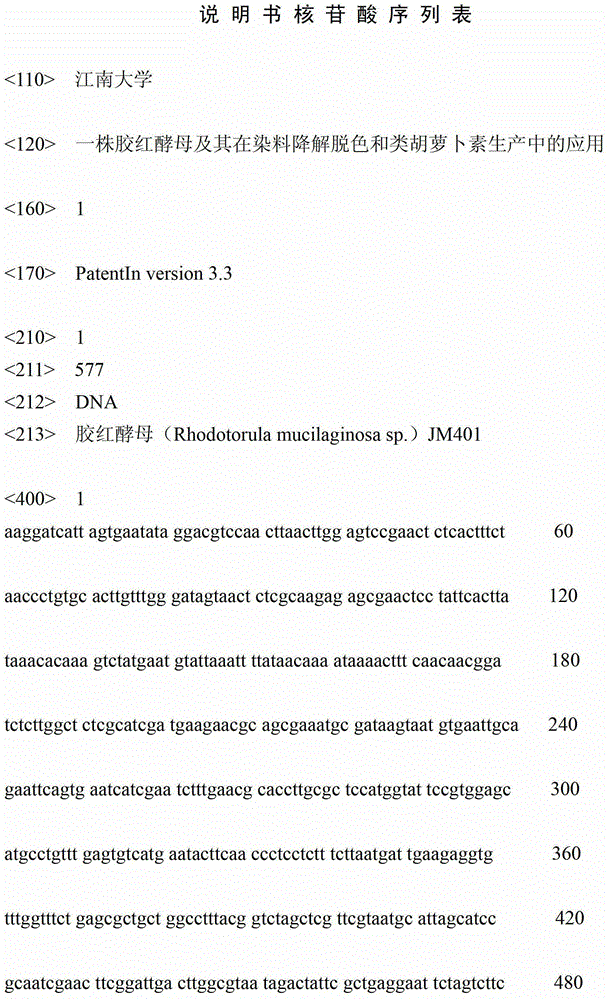Rhodotorula mucilaginosa and application thereof in degradation and decoloring of dyes and production of carotenoid
A technology of Rhodotorula gum and carotene, applied in the direction of microorganism-based methods, fermentation, microorganisms, etc., can solve the problems of less research and triphenylmethane dyes that have not been reported, and achieve broad application prospects, efficient and significant degradation and decolorization effects Effect
- Summary
- Abstract
- Description
- Claims
- Application Information
AI Technical Summary
Problems solved by technology
Method used
Image
Examples
Embodiment 1
[0019] Example 1 Screening and Separation of Rhodotorula japonicus JM401 CCTCC M 2013088
[0020] Glue Rhodotorula jM401 CCTCC M 2013088 was isolated from tobacco stems produced in Luzhou, Sichuan in October 2011; 5g of tobacco stems were placed in a 250ml sterilized Erlenmeyer flask containing 10 small glass beads, 100ml of sterile saline was added, and the mixture was heated at 30°C. Shake the culture at 150r / min for 20min on a shaker and let it stand for 2h; take the above bacterial suspension and dilute it by 10 5 、10 6 、10 7 times, take 100 μl and spread on the water-soluble aniline blue plate (the composition of the water-soluble aniline blue plate is calculated in g / L: peptone 10, yeast extract 5, sodium chloride 5, aniline blue 2, agar 15, and the remaining components are water, pH5 .5, sterilized at 121°C for 15 minutes), repeated three times for each concentration, cultured at 32°C for 40 hours, selected a single colony with a large transparent circle for multiple ...
Embodiment 2
[0022] Example 2 Identification of Rhodotorula japonicus JM401 CCTCC M 2013088
[0023] (1) Morphological characteristics
[0024] After culturing on the slant medium for 40 hours, microscopic observation: the diameter of the colony is about 2 mm, with oval protrusions, neat edges, smooth surface, sticky shape, and carotenoid pigments; in the seed medium, the strain grows for 20 hours to reach Several phases; the growth is best at 32°C.
[0025] (2) ITS-5.8S rDNA sequence analysis
[0026] The target strain was cultured on slant medium for 24 hours, and the ITS-5.8S rDNA sequence of the strain was amplified by PCR technology. The oligonucleotide primers were: TCCGTAGGTGAACCTGCGG (ITS1) and TCCTCCGCTTATTGATATGC (ITS4), and the amplified products were delivered to Shanghai Sequencing was performed by Sangon Bioengineering Technology Service Co., Ltd., and its sequence is shown in SEQ ID NO:1. The sequence results were compared with the known ITS-5.8S rDNA sequence in GeneBank...
Embodiment 3
[0037] Embodiment 3 single batch degradation decolorization culture
[0038] Take 40ml of the cultured activated seed solution, load it into two 50ml sterile centrifuge tubes, each centrifuge tube contains 20ml, centrifuge at 8000r / min for 10min, discard the supernatant, collect all the bacteria and transfer them to a 100ml Erlenmeyer flask 40ml of decolorization medium with an initial concentration of 50mg / L crystal violet, pH 6.0, cultured with shaking at 37°C for 2h at a shaker speed of 150r / min to obtain a decolorization medium. The degradation and decolorization rate of crystal violet reached 92.35%.
PUM
| Property | Measurement | Unit |
|---|---|---|
| diameter | aaaaa | aaaaa |
Abstract
Description
Claims
Application Information
 Login to View More
Login to View More - R&D
- Intellectual Property
- Life Sciences
- Materials
- Tech Scout
- Unparalleled Data Quality
- Higher Quality Content
- 60% Fewer Hallucinations
Browse by: Latest US Patents, China's latest patents, Technical Efficacy Thesaurus, Application Domain, Technology Topic, Popular Technical Reports.
© 2025 PatSnap. All rights reserved.Legal|Privacy policy|Modern Slavery Act Transparency Statement|Sitemap|About US| Contact US: help@patsnap.com



